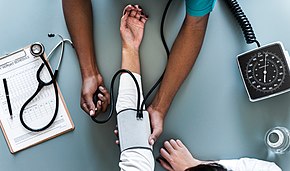 Global Information
Global InformationBlood pressure information
| Blood pressure | |
|---|---|
 A healthcare worker measuring blood pressure using a sphygmomanometer. | |
| MeSH | D001795 |
| MedlinePlus | 007490 |
| LOINC | 35094-2 |
Blood pressure (BP) is the pressure of circulating blood against the walls of blood vessels. Most of this pressure results from the heart pumping blood through the circulatory system. When used without qualification, the term "blood pressure" refers to the pressure in a brachial artery, where it is most commonly measured. Blood pressure is usually expressed in terms of the systolic pressure (maximum pressure during one heartbeat) over diastolic pressure (minimum pressure between two heartbeats) in the cardiac cycle. It is measured in millimeters of mercury (mmHg) above the surrounding atmospheric pressure, or in kilopascals (kPa). The difference between the systolic and diastolic pressures is known as pulse pressure,[1] while the average pressure during a cardiac cycle is known as mean arterial pressure.[2]
Blood pressure is one of the vital signs—together with respiratory rate, heart rate, oxygen saturation, and body temperature—that healthcare professionals use in evaluating a patient's health. Normal resting blood pressure in an adult is approximately 120 millimetres of mercury (16 kPa) systolic over 80 millimetres of mercury (11 kPa) diastolic, denoted as "120/80 mmHg". Globally, the average blood pressure, age standardized, has remained about the same since 1975 to the present, at approx. 127/79 mmHg in men and 122/77 mmHg in women, although these average data mask significantly diverging regional trends.[3]
Traditionally, a health-care worker measured blood pressure non-invasively by auscultation (listening) through a stethoscope for sounds in one arm's artery as the artery is squeezed, closer to the heart, by an aneroid gauge or a mercury-tube sphygmomanometer.[4] Auscultation is still generally considered to be the gold standard of accuracy for non-invasive blood pressure readings in clinic.[5] However, semi-automated methods have become common, largely due to concerns about potential mercury toxicity,[6] although cost, ease of use and applicability to ambulatory blood pressure or home blood pressure measurements have also influenced this trend.[7] Early automated alternatives to mercury-tube sphygmomanometers were often seriously inaccurate, but modern devices validated to international standards achieve an average difference between two standardized reading methods of 5 mm Hg or less, and a standard deviation of less than 8 mm Hg.[7] Most of these semi-automated methods measure blood pressure using oscillometry (measurement by a pressure transducer in the cuff of the device of small oscillations of intra-cuff pressure accompanying heartbeat-induced changes in the volume of each pulse).[8]
Blood pressure is influenced by cardiac output, systemic vascular resistance, blood volume and arterial stiffness, and varies depending on patient's situation, emotional state, activity and relative health or disease state. In the short term, blood pressure is regulated by baroreceptors, which act via the brain to influence the nervous and the endocrine systems.
Blood pressure that is too low is called hypotension, pressure that is consistently too high is called hypertension, and normal pressure is called normotension.[9] Both hypertension and hypotension have many causes and may be of sudden onset or of long duration. Long-term hypertension is a risk factor for many diseases, including stroke, heart disease, and kidney failure. Long-term hypertension is more common than long-term hypotension.
- ^ Homan TD, Bordes SJ, Cichowski E (12 July 2022). "Physiology, Pulse Pressure". StatPearls [Internet]. Treasure Island (FL): StatPearls Publishing. PMID 29494015. Retrieved 2019-07-21 – via NCBI Bookshelf.
- ^ Mayet J, Hughes A (September 2003). "Cardiac and vascular pathophysiology in hypertension". Heart. 89 (9): 1104–1109. doi:10.1136/heart.89.9.1104. PMC 1767863. PMID 12923045.
- ^ Zhou B, Bentham J, Di Cesare M, Bixby H, Danaei G, Cowan MJ, et al. (NCD Risk Factor Collaboration (NCD-RisC)) (January 2017). "Worldwide trends in blood pressure from 1975 to 2015: a pooled analysis of 1479 population-based measurement studies with 19·1 million participants". Lancet. 389 (10064): 37–55. doi:10.1016/S0140-6736(16)31919-5. PMC 5220163. PMID 27863813.
- ^ Cite error: The named reference
Booth1977was invoked but never defined (see the help page). - ^ Grim CE, Grim CM (March 2016). "Auscultatory BP: still the gold standard". Journal of the American Society of Hypertension. 10 (3): 191–193. doi:10.1016/j.jash.2016.01.004. PMID 26839183.
- ^ O'Brien E (January 2001). "Blood pressure measurement is changing!". Heart. 85 (1): 3–5. doi:10.1136/heart.85.1.3. PMC 1729570. PMID 11119446.
- ^ a b Ogedegbe G, Pickering T (November 2010). "Principles and techniques of blood pressure measurement". Cardiology Clinics. 28 (4): 571–586. doi:10.1016/j.ccl.2010.07.006. PMC 3639494. PMID 20937442.
- ^ Alpert BS, Quinn D, Gallick D (December 2014). "Oscillometric blood pressure: a review for clinicians". Journal of the American Society of Hypertension. 8 (12): 930–938. doi:10.1016/j.jash.2014.08.014. PMID 25492837.
- ^ Newman WA, ed. (2012). Dorland's illustrated medical dictionary (32nd ed.). Philadelphia, PA: Saunders/Elsevier. ISBN 978-1-4160-6257-8. OCLC 706780870.